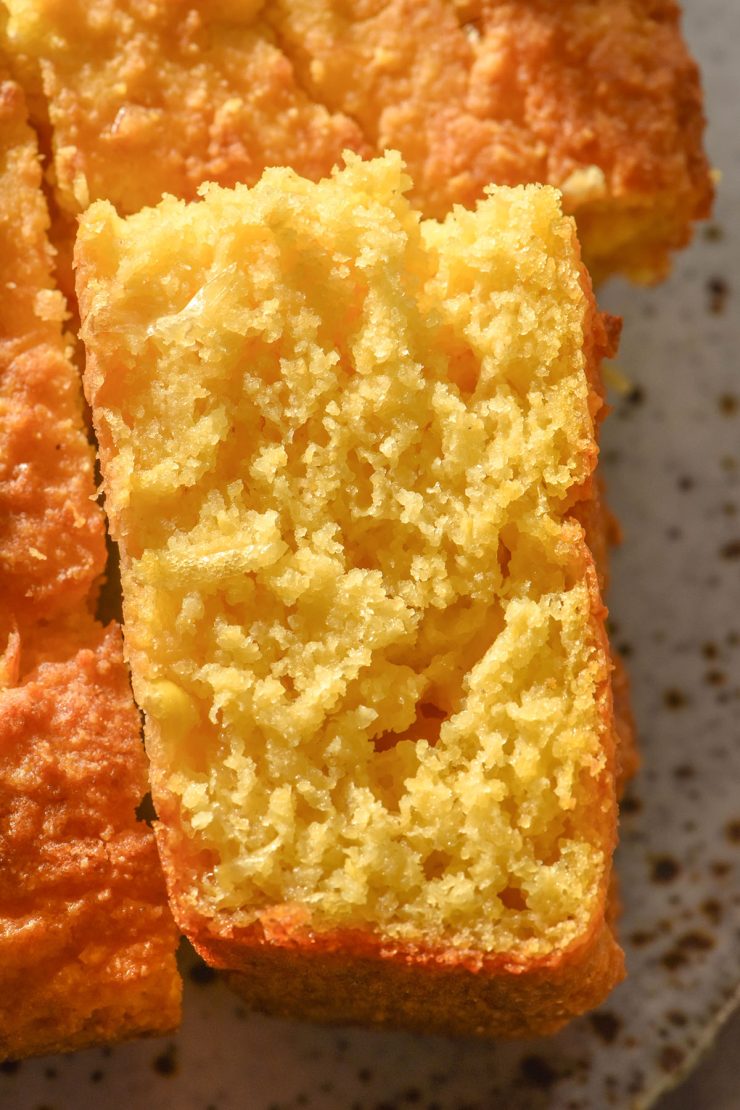
Before we begin, a caveat: I have never eaten cornbread prior to developing this recipe. As an Australian, it’s not really something that is regularly on the menu. I wanted to see if I could challenge myself to develop a recipe for gluten free cornbread without eggs, and I think I have nailed it. Hopefully it’s helpful for people who need to avoid both eggs and gluten.
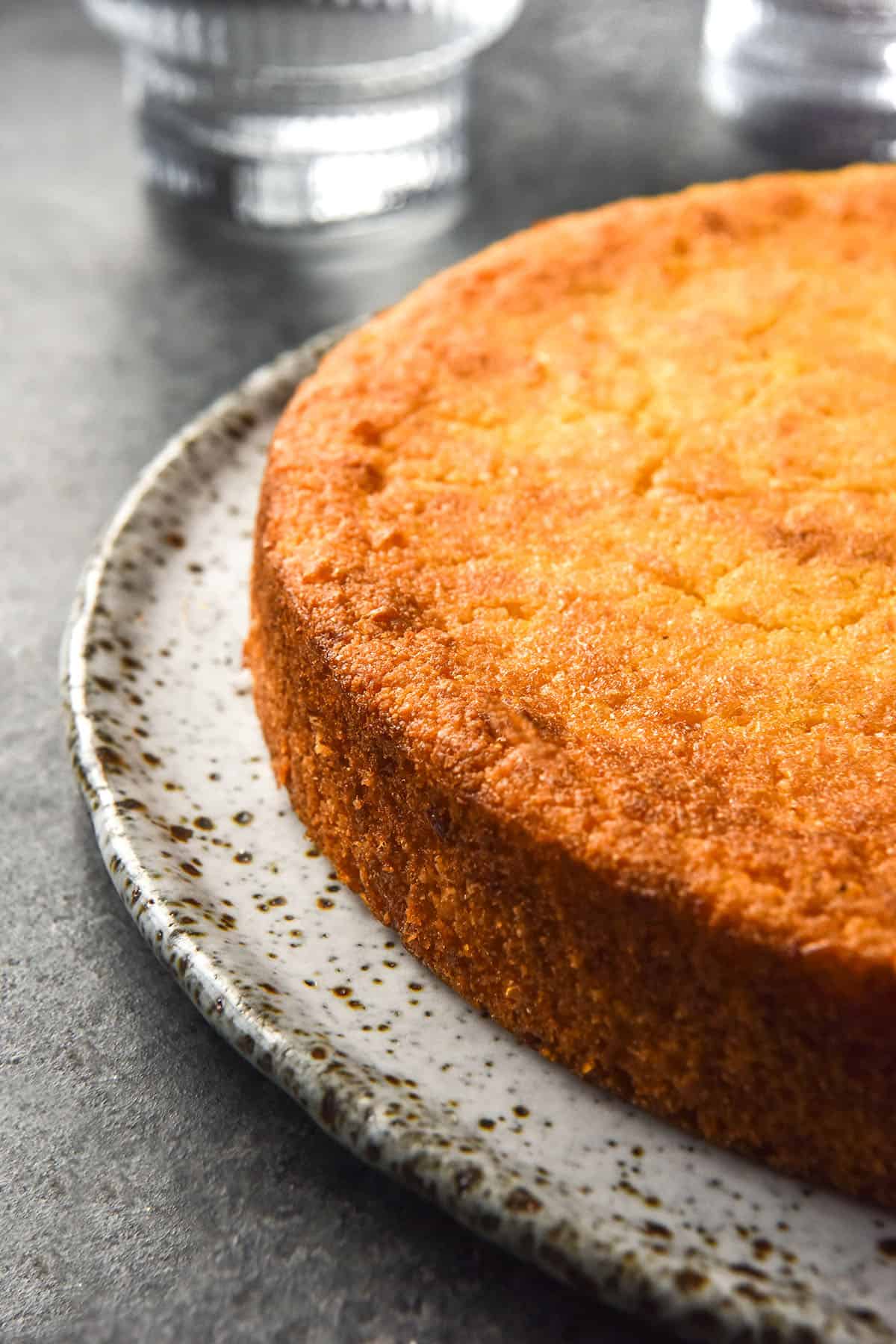
Gluten free cornbread without eggs
I did a lot of research to develop this recipe as I wanted to make sure I got it right. There is a lot of debate online as to what traditional cornbread is. Southern cornbread, according to my research, is normally savoury and made with all cornmeal (no flour). Some websites suggest it is made in a skillet with bacon grease and is on the more crumbly side texture wise.
Northern cornbread, according to my research, is a sweeter variety that often uses half flour and half cornmeal. Some recipes are sweet sweet, while others are subtly sweet.
This recipe is a cross between the two. It uses majority cornmeal and is only a little bit sweet. It can be fluffy or dense, according to how much milk (if any) you add.
Because the bread does not contain any eggs, we’re using canned creamed corn and yoghurt along with a small amount of tapioca flour to bind everything together. These ingredients create a moist cornbread with the perfect amount of crumbly texture. The tapioca flour works to lighten the cornbread a little bit, but also to replace the binding capacity of eggs.
Butter and honey add flavour and texture, while baking soda and powder give the cornbread a bit of lift. I have tested agave syrup in place of the honey and it worked well, so I daresay maple syrup would also be a good stand in.
I would describe it as a medium density cornbread that is a tiny bit sweet but mostly savoury. It has a good moist texture with a small amount of classic crumbliness.
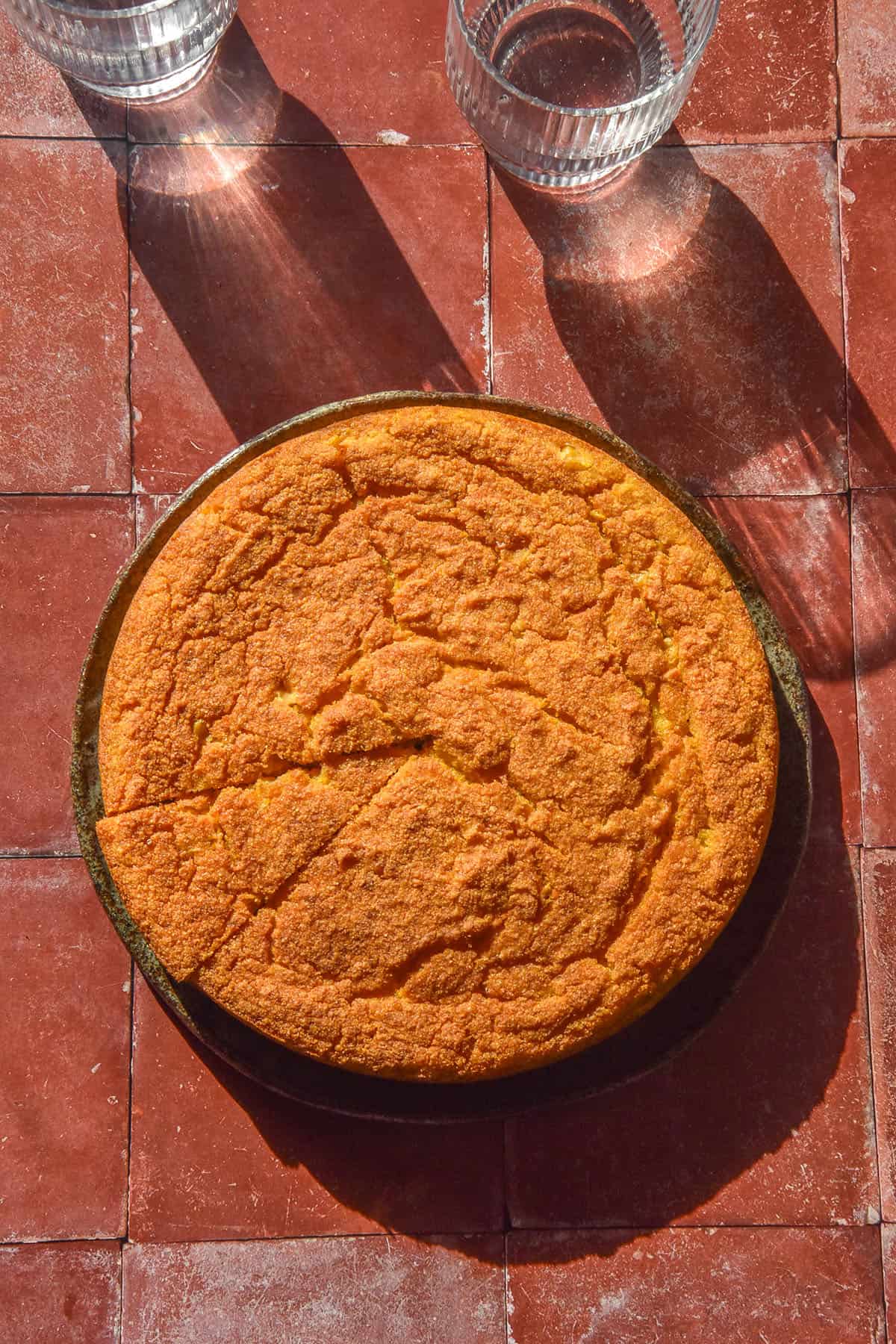
Ingredient notes for your gluten free cornbread
- We will discuss corn meal, polenta and corn flour below because they are quite complex.
- I recommend a thick, creamy Greek yoghurt for this recipe. It should be so thick that you need to dig the spoon into the container, rather than being able to pour it out. I use Jalna Greek yoghurt (the regular is also fine, I just need lactose free for large amounts of dairy). Note that ‘Greek style’ is not the same as Greek yoghurt. it is generally strained for a shorter amount of time which means it will be more runny. Chobani Fit is another lactose free option that contains a lot more protein than Jalna, if that’s important to you.
- Canned creamed corn adds extra corn flavour, binding and moisture to your corn bread. It should have a very short list of ingredients – corn, sugar, water, salt and perhaps a thickener like cornstarch.
- Double check that you have sweet corn and not regular canned corn. The viscous nature of sweet corn helps bind the cornbread, whereas corn kernels are just corn kernels. Sweet corn also adds a subtle hint of sweetness to the bread.
- For my American readers, note that canned cream corn is the not the same as homemade creamed corn, which seems to be corn in a flour based roux. It might be called canned sweet corn.
- Different brands of creamed corn/sweet corn have different levels of sweetness. In Australia, I found that Edgell a good balance of sweetness.
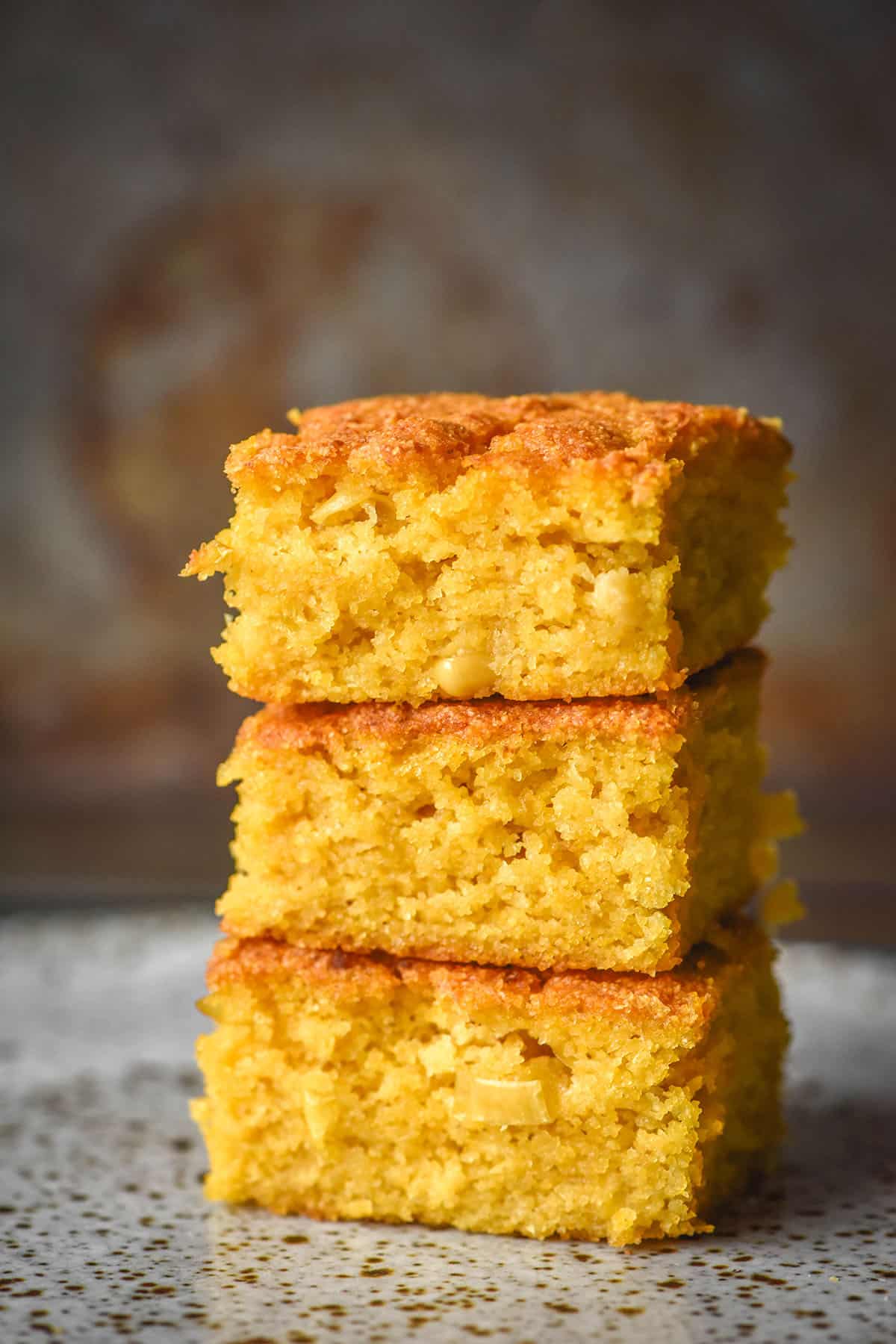
Can I use polenta instead of cornmeal?
The topic of cornmeal vs polenta is incredibly confusing. They are both made of the same thing (ground corn) but no resource that I found clearly defined each product, how they are different and how that impacts their absorbency levels.
Whatever the case; yes, you can use polenta in this recipe. In Australia, polenta is cornmeal that may or may not be more coarsely ground than corn meal. If you read the back of the polenta packet, it should be 100% corn meal. Unfortunately for us, brands generally don’t specify how coarsely the ‘polenta’ is ground, so it’s a matter of finding a brand you like.
There is a caveat: instant polenta is made from corn that has already been cooked. This makes it a little bit different from regular polenta (and corn meal) as they are not pre-cooked. Because this recipe contains a number of binding and texture improving ingredients, it should not make too much of a difference. However, if you are having issues you should double check the polenta you are using.
I have tested this recipe with various brands of polenta and Bob’s Red Mill yellow cornmeal. I have also used half polenta and half Bob’s Red Mill Corn flour. The polenta brand I liked the most in Australia was Marco Polo. I also tried Divella quick polenta (which is cooked) but found it too thirsty.

Can I use white corn meal instead of yellow corn meal?
I haven’t tried this. Yellow corn meal seems to be the main variety sold here in Australia and it was even difficult to find that. A quick search tells me that they are pretty much the same aside from the colour, but I have not confirmed this. If you try, let me know how it goes!
Texture tips and troubleshooting your gluten free cornbread
First and foremost: this is a savoury recipe. If you are after a sweet cornbread recipe, see my cornbread muffin recipe. You can make this in an 8 inch (20cm) round cake pan or an 8 inch (20cm X 20cm) square baking tin.
- Before we get into specific tips, keep in mind the type of corn meal you are using. I found that pre-cooked corn meal (instant polenta) was more absorbent and needed more milk to create a soft result. Corn flour (which is a completely different product than cornstarch) was even drier again.
- Keep the variety of corn meal you are using in mind when you make the substitutions below. You don’t want to drop back the liquids if you’re using corn flour, for example.
- For a crumblier cornbread, omit the (optional) milk. If you like it crumblier again, drop the butter back to 75g.
- For a chewier, more (dense) cake-like cornbread, use 75g tapioca flour.
- If your cornbread is too wet, omit the milk and/or drop the butter back to 75g.
- For a fluffier cornbread, use 1/2 corn flour (the yellow variety, not corn starch) and 1/2 polenta or corn meal. This was a great balance that resulted in a fluffy yet moist cornbread.
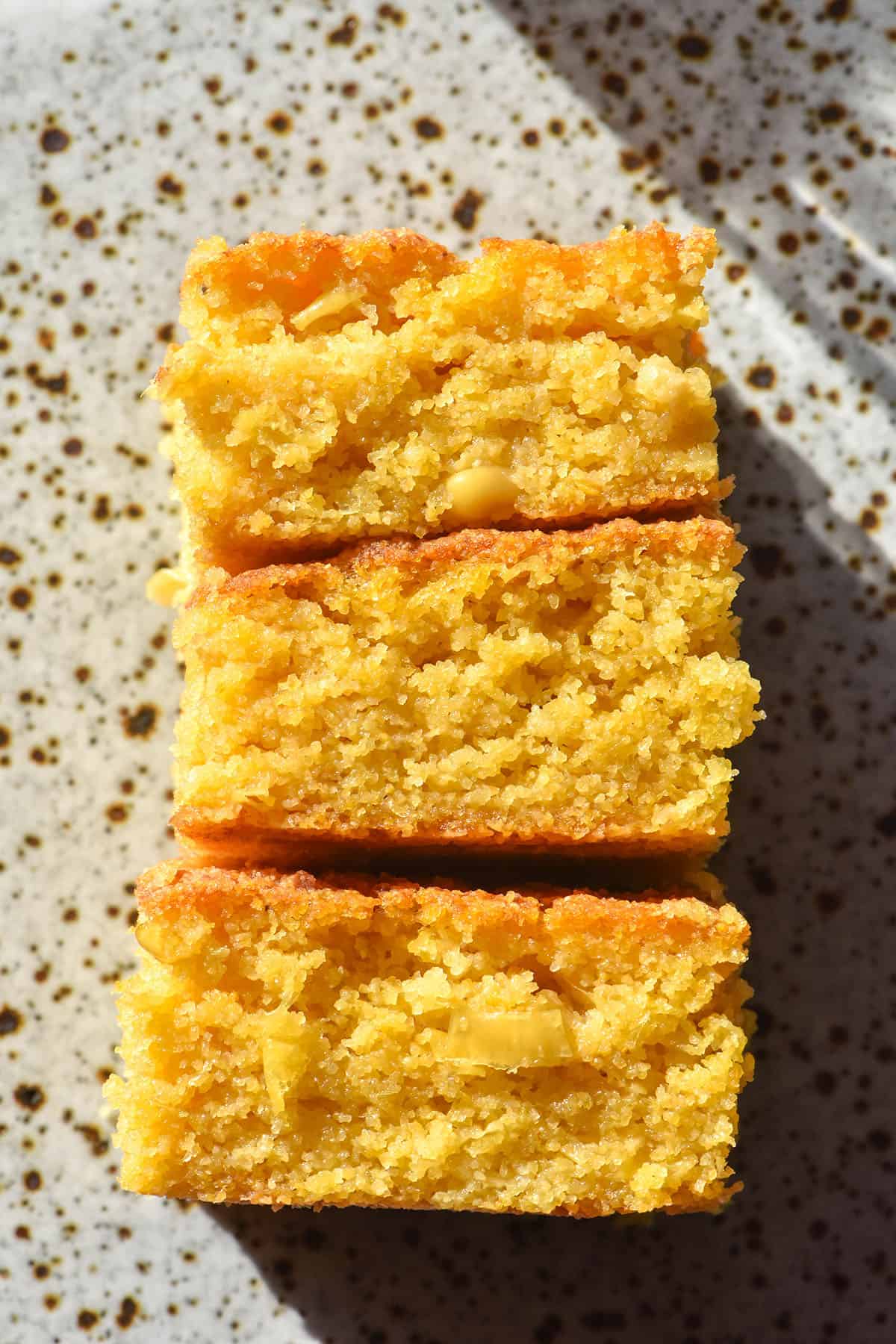
What should the batter look like before baking?
This is somewhat of a tricky question to answer because it depends on the corn meal you use. Some are quite absorbent and some are quite course. The courser varieties make a batter that looks like a split buttercream cake batter. It has the appearance of a cake batter that hasn’t fully absorbed the milk, resulting in liquid and solids remaining a little bit separate. The look is subtle, but you’ll know it if you make cakes often.
Prior to pouring the mixture into the baking dish, your batter should feel and look very light and fluffy. It will be around the consistency of a medium thickness muffin batter, but won’t have a cohesive look or feel. Corn is a little bit gritty and has no elasticity, so the batter will look and feel a bit silty. Again, it will look a bit like a split buttercream cake batter.
How much milk to add/whether to add any milk at all will depend on the corn you are using. The batter has three moisture providing ingredients (butter, creamed corn and yoghurt) so ideally it won’t be too dry any which way.

More gluten free recipes
- Gluten free cinnamon rolls without yeast
- Gluten free vegan chocolate chip cookies
- Gluten free bagels without xanthan gum
- Low FODMAP vegan chilli
- Ninja Creami chocolate mint chip ice cream
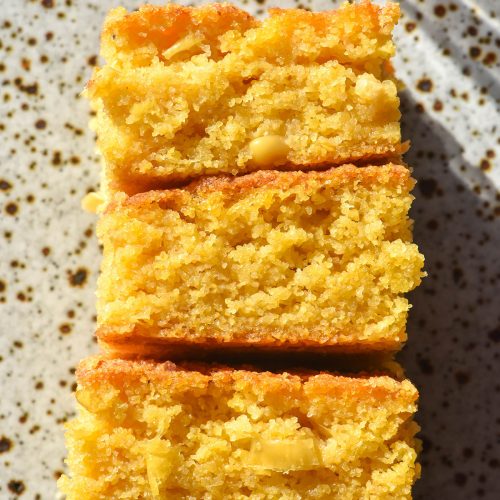
Gluten free cornbread without eggs
Equipment
- 8 Inch (20cm) cake tin in a square or round shape
Ingredients
Dry ingredients:
- 250 g corn meal or polenta (see notes)
- 50 g tapioca flour
- 5g (1 teaspoon)* baking powder
- 3.5g (1/2 teaspoon)* baking soda
- 5g (1 teaspoon)* fine salt (I used table salt) (use 2.5g or 1/2 teaspoon if your creamed corn is quite salty or if you prefer things less salty)
Wet ingredients:
- 350 g canned creamed corn/sweet corn (not regular canned corn kernels or fresh corn and not homemade creamed corn, which is not the same thing)
- 150 g plain thick Greek yoghurt (see notes)
- 25g (1 tablespoon)* honey
- 75-100 g butter, melted (salted or unsalted)
- 10ml (2 teaspoons)* lemon juice or neutral vinegar (white vinegar or apple cider vinegar)
To finish:
- 60ml (1/4 cup)* milk, as necessary (see notes)
Instructions
- Preheat the oven to 200C/400F. Grease and line an 8 inch cake tin – square or round.
- Whisk the dry ingredients together in a large mixing bowl.
- Whisk the wet ingredients (not the milk) together in a medium mixing bowl. Make sure all the honey is mixed in as opposed to sitting in a clump.
- Whisk the wet ingredients into the dry ingredients thoroughly, ensuring everything is evenly distributed.
- Assess your batter: it should look roughly the consistency of a muffin batter, although more silty. It could look a bit like a split butter cake mixture. You should be able to whisk it quite easily without encountering resistance or dry spots. The consistency should be very airy and bubbly but not dry or stiff. The centre of the bowl might have slightly more resistance as you whisk than the outer edges.
- If your mixture is drier than that described above, add some or all of the milk. If it looks good, pour the mixture into your pre-prepared tin. With the right consistency, your mixture should need a spatula to smooth it out in the baking tin, but it should not be super dry.
- I like to use moistened hands to press down the top of the cornbread to create an even surface. It will still crack a bit in the oven, but this just helps give it a neater appearance.
- Place your cornbread in the oven and bake for 25-30 minutes or until golden brown and firm to the touch. Remove it from the oven and allow to cool before touching it. This is important as the cornbread doesn't have eggs and is therefore quite fragile before it cools.
- Leftovers keep well for a number of days in an airtight container in the fridge. They can also be frozen and defrosted.
Notes
- See the notes in the body of the post on using different types of corn meal – polenta, corn flour (not corn starch) etc.
- I have not tested a substitute for tapioca flour. It is a very important ingredient as it replaces binding and a bit of elasticity that is missing without the eggs.
- Greek yoghurt is thicker than ‘Greek style’ yoghurt. I recommend using Greek yoghurt here so it doesn’t contribute too much liquid. I like Jalna lactose free Greek yoghurt. It is pot set so it is super thick.
- Canned creamed corn is different to canned corn. Regular canned corn will not work here. Canned creamed corn is different to homemade creamed corn – it should contain just corn, sugar, water and maybe a bit of salt.
- If your creamed corn is quite salty, you might need to add less salt than the recipe specifies.
- I am working on a gluten free vegan cornbread which will be suitable for those who need to avoid dairy. Stay tuned.

No Comments